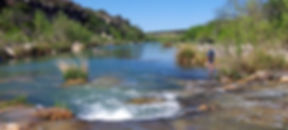Oasis Fire - then and now (part 1)
The Junction Eagle April 1, 2015 by James Murr and Scott Richardson
In April 2011, a time of severe drought, a large fire was started by a smoldering lighting strike around 14 miles southwest of Junction near the end of Kimble County Road 130. The severe fire that burned around 9,000 acres came to be known as the OASIS Pipeline Fire. During the course of the fire, from April 24 to May 10, it threatened at times to reach the City of Junction. On Saturday, April 18th, four years after the fire, there will be a workshop to provide information about recovery of the land, water and wildlife, and the recovery strategies that were undertaken. The workshop will begin at 8:30 a.m. at the Texas Tech Center at Junction and will include a visit to some of the burned acreage ending with a picnic lunch. This is the first of three articles about the fire.
It reviews the extent of the OASIS fire; the cooperative efforts of local, state, and federal fire fighters; and the beginning of a process to identify ways to help the land recover from the extensive fire damage. A second article will address different land restoration and recovery techniques that were undertaken. The third and final article will report on the April 18th workshop that will include a number of fire-related activities, including a tour of the burned acreage and the results of restoration and recovery efforts.
After the outbreak of the OASIS fire, personnel and equipment were staged on a field along U.S. 377, but, as the extent and severity of the fire increased, the staging area was relocated to the Texas Tech Center and an Incident Command Post was established. This was facilitated by the cooperative efforts of Tech’s Robert Stubblefield and Raymond McDonald with the Texas Forest Service. As the fire progressed, significant resources from across the state, as well as federal resources, were deployed.
In addition to the local community’s firefighting resources, there were over 20 volunteer fire departments engaged in fighting the fire, including fire trucks from Hays and Travis counties. A total of 11 city and county fire departments committed resources and resources from 11 Emergency Medical Services were made available. The Pedernales Electric Cooperative also provided assistance.
At the state level, the Texas Forest Service provided trucks and crews. The U.S. Forest Service provided a “hot shot” crew and three task forces composed of fire engines, bulldozers, two firefighting helicopters (dropping in excess of 20,000 gallons of water a day), and two C-130 cargo planes used to drop fire retardant.
The cost of fighting the fire was a little over $206,000 and the Kimble County Commissioners Court applied for and received a grant of $154,790 from the Federal Emergency Management Agency to help cover these costs. A total of $29,910 in donations was also made to help offset costs. The remainder was paid for by the county.
After the fire was contained, an evaluation of the severity of the burn began and it became apparent that the damage, with around 1,500 acres on steep slopes, posed a very real threat to riparian and aquatic habitat. For those of us not acquainted with the term “riparian”, it is the area of interface between land and a river or stream, in this case the South Llano River and some of its tributaries. The river also provides habitat for the state fish, the Guadalupe Bass, which is found only in Hill Country rivers and is threatened by hybridization with non-native small mouth bass and loss of habitat. In response to this threat, Tyson Broad, a co-founder and advisor to the South Llano Watershed Alliance (SLWA), contacted Tim Birdsong and Garry Garrett with the Texas Parks and Wildlife Department (TPWD) to determine ways to address this potential threat.
In July 2011, a meeting of 30 experts was convened by the SLWA and TPWD at the Llano River Field Station at Texas Tech-Junction. The experts toured the fire-scorched area and reached a consensus that this fire was unique in terms of the interactions of extreme drought prior to a fire, a highly intense fire, and extreme drought continuing after the fire. Many wondered if some of the land had been sterilized by the fire’s extreme temperatures and would not grow anything for years to come.
So, what could be done to deal with the threat to the riparian and aquatic habitat? The second article in this series will address the recommendations made by the experts group to deal with this problem and the land restoration and recovery activities that were undertaken on demonstration sites.
The third article will report on the April 18th workshop, which will address the recovery of the land, water and wildlife, and the results of recovery strategies that were undertaken. One may register by April 12th for the workshop by contacting Scott Richardson at 325-475-2271 or scottr@ctesc.net or register on-line by going to www.southllano.org.
(Note: The information in this article was compiled primarily by Scott Richardson while he served as the Board Chair for the SLWA and is also derived from material prepared by the TPWD, the Texas Forest Service, and the County of Kimble. Other contributors are Gary Garrett, Research Associate, University of Texas, and Megan Bean, Watershed Ecologist, TPWD.)




